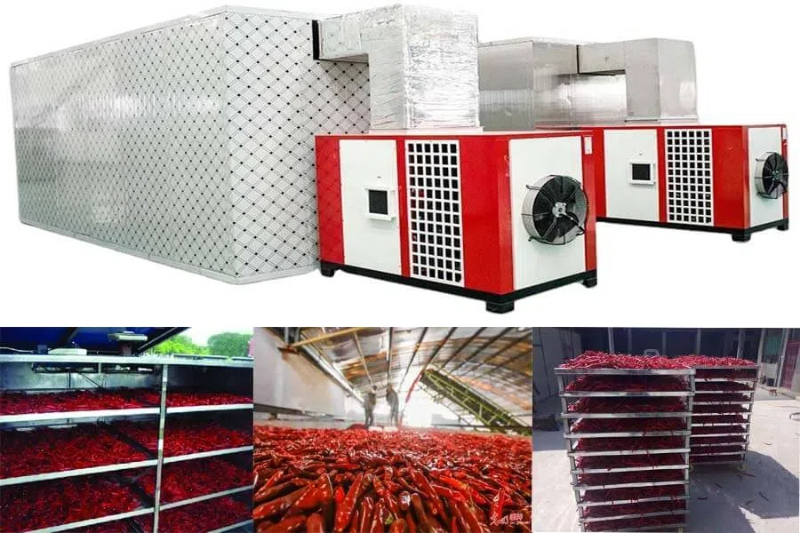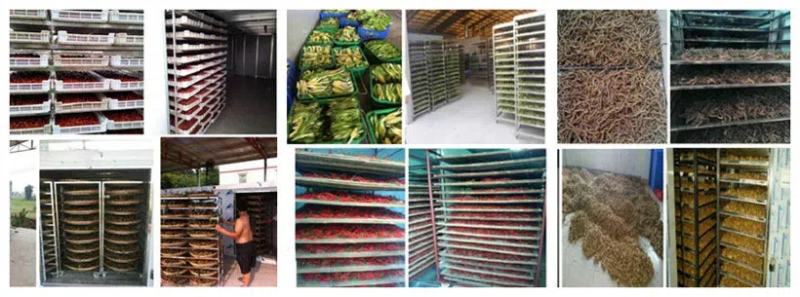
Content Menu
● Introduction to Industrial Food Drying
● The Technology Behind Industrial Food Dehydrator Machines
● Applications of Commercial Food Drying Equipment
● Factors Affecting the Cost of Industrial Food Drying Machines
● Cost Ranges for Commercial Food Dehydrator Equipment
● Emerging Trends in Industrial Food Drying Technology
● Choosing the Right Industrial Food Drying Machine
● The Future of Industrial Food Drying
● Conclusion
● Frequently Asked Questions
>> 1. Q: What is the average lifespan of an industrial food drying machine?
>> 2. Q: How do I determine the right size of industrial food dehydrator for my business?
>> 3. Q: Are there any government regulations I need to be aware of when using industrial food drying equipment?
>> 4. Q: How can I reduce energy costs associated with industrial food drying?
>> 5. Q: What are the main differences between batch and continuous industrial food dryers?
Introduction to Industrial Food Drying
Industrial food drying machines play a crucial role in modern food processing and preservation. These sophisticated pieces of equipment are designed to remove moisture from various food products, extending their shelf life, reducing transportation costs, and preserving nutritional value. As the global demand for dried foods continues to rise, understanding the technology, applications, and cost considerations of industrial food drying machines becomes increasingly important for food manufacturers and processors.
The Technology Behind Industrial Food Dehydrator Machines
Industrial food dehydrator machines utilize advanced technologies to efficiently remove moisture from food products. These machines typically employ one or more of the following drying methods:
1. Hot Air Drying: This is the most common method used in industrial food drying machines. Hot air is circulated through the drying chamber, gradually removing moisture from the food products.
2. Freeze Drying: This method involves freezing the food and then reducing the surrounding pressure to allow the frozen water in the food to sublimate directly from the solid phase to the gas phase.
3. Spray Drying: Liquid foods are atomized into fine droplets and exposed to hot air, instantly drying them into a powder form.
4. Microwave Drying: This method uses microwave energy to heat the water molecules within the food, causing them to evaporate rapidly.
5. Osmotic Dehydration: This process involves immersing food in a concentrated solution, which draws out moisture through osmosis.
Modern industrial food drying equipment often combines multiple drying technologies to achieve optimal results. For example, some machines may use a combination of hot air and microwave drying to increase efficiency and reduce drying time.
Applications of Commercial Food Drying Equipment
The versatility of industrial food drying machines allows for a wide range of applications across various sectors of the food industry. Some common applications include:
1. Fruit and Vegetable Dehydration: Industrial fruit and vegetable dryers are used to produce dried fruits, vegetable chips, and powders for use in snacks, cereals, and food ingredients.
2. Meat and Fish Processing: Large-scale food dehydration systems are employed to create jerky, dried fish, and other preserved meat products.
3. Dairy Processing: Spray drying technology is often used to produce milk powder, whey protein, and other dairy-based ingredients.
4. Herb and Spice Drying: Commercial food drying equipment is essential for preserving and processing herbs and spices while maintaining their flavor and aroma.
5. Pet Food Manufacturing: Industrial food processing dryers are used to create dry pet food kibbles and treats.
6. Nutraceutical and Functional Food Production: High-capacity food drying technology is utilized in the production of dietary supplements and functional food ingredients.

Factors Affecting the Cost of Industrial Food Drying Machines
When considering the investment in an industrial food dehydrator machine, several factors can influence the overall cost:
1. Capacity: The size and throughput capacity of the machine significantly impact its price. Larger, high-capacity food drying systems generally come with a higher price tag.
2. Technology: The type of drying technology employed affects the cost. For example, freeze-drying equipment tends to be more expensive than conventional hot air dryers.
3. Energy Efficiency: More energy-efficient models may have a higher upfront cost but can lead to significant savings in operating expenses over time.
4. Automation and Control Systems: Advanced control systems and automation features can increase the initial cost but may improve efficiency and product consistency.
5. Material Quality: Industrial-grade food dehydration equipment made with high-quality, food-safe materials will generally be more expensive than lower-grade alternatives.
6. Customization: Tailored solutions to meet specific processing requirements can add to the overall cost of the machine.
7. Brand and Manufacturer Reputation: Well-established food drying machine manufacturers may charge a premium for their products based on their reputation and after-sales support.
Cost Ranges for Commercial Food Dehydrator Equipment
The cost of industrial food drying machines can vary widely depending on the factors mentioned above. Here's a general overview of price ranges:
1. Small to Medium-Scale Equipment: For smaller operations or pilot plants, industrial food dehydrator machines can range from $5,000 to $50,000.
2. Large-Scale Industrial Systems: High-capacity food drying systems for large-scale production can cost anywhere from $50,000 to several million dollars.
3. Specialized Drying Equipment: Cutting-edge technologies like freeze-dryers or specialized pharmaceutical-grade drying systems can exceed $1 million.
It's important to note that the initial purchase price is just one aspect of the total cost of ownership. Operators should also consider ongoing expenses such as energy consumption, maintenance, and potential upgrades when evaluating the long-term cost of industrial food drying equipment.
Emerging Trends in Industrial Food Drying Technology
The field of industrial food drying is continuously evolving, with new technologies and approaches emerging to meet the changing demands of the food industry. Some current trends include:
1. Energy Efficiency: There is a growing focus on developing more energy-efficient drying systems to reduce operating costs and environmental impact.
2. Smart Technology Integration: Industrial food processing dryers are increasingly incorporating IoT (Internet of Things) capabilities for remote monitoring, predictive maintenance, and process optimization.
3. Hybrid Drying Systems: Combining multiple drying technologies in a single machine to optimize efficiency and product quality.
4. Gentle Drying Techniques: Development of drying methods that better preserve the nutritional content, flavor, and texture of food products.
5. Sustainable Practices: Integration of renewable energy sources, such as solar power, into industrial food drying processes.

Choosing the Right Industrial Food Drying Machine
When selecting an industrial food dehydrator machine for your operation, consider the following factors:
1. Product Requirements: Different food products may require specific drying conditions. Ensure the machine can handle your product's unique characteristics.
2. Production Capacity: Choose a machine that can meet your current production needs and allow for future growth.
3. Space Constraints: Consider the available floor space in your facility and the machine's footprint.
4. Energy Efficiency: Look for energy-efficient models to reduce long-term operating costs.
5. Ease of Cleaning and Maintenance: Choose equipment that is easy to clean and maintain to ensure food safety and minimize downtime.
6. Regulatory Compliance: Ensure the machine meets all relevant food safety and industry regulations.
7. After-Sales Support: Consider the manufacturer's reputation for customer support and availability of spare parts.
The Future of Industrial Food Drying
As the global demand for dried and preserved foods continues to grow, the industrial food drying industry is poised for significant advancements. Future developments may include:
1. Increased Automation: Further integration of artificial intelligence and machine learning to optimize drying processes.
2. Novel Drying Methods: Development of new drying technologies that offer improved efficiency and product quality.
3. Sustainability Focus: Greater emphasis on eco-friendly drying solutions and circular economy principles in equipment design.
4. Customization and Flexibility: More adaptable drying systems capable of handling a wider variety of food products with minimal reconfiguration.
5. Enhanced Quality Control: Integration of real-time quality monitoring systems to ensure consistent product quality.
Conclusion
Industrial food drying machines are essential components in modern food processing and preservation. As technology continues to advance, these machines are becoming more efficient, versatile, and capable of producing higher quality dried food products. While the cost of industrial food dehydrator machines can be significant, the long-term benefits in terms of product quality, shelf life extension, and operational efficiency often justify the investment.
For food manufacturers and processors considering the adoption or upgrade of their drying capabilities, it's crucial to carefully evaluate their specific needs, budget constraints, and long-term goals. By choosing the right industrial food drying equipment and staying informed about emerging trends and technologies, businesses can position themselves for success in the ever-evolving food industry landscape.

Frequently Asked Questions
1. Q: What is the average lifespan of an industrial food drying machine?
A: The lifespan of an industrial food drying machine can vary depending on usage, maintenance, and quality of construction. On average, a well-maintained machine can last 15-20 years or more. However, it's important to note that technological advancements may make it beneficial to upgrade sooner to take advantage of improved efficiency and capabilities.
2. Q: How do I determine the right size of industrial food dehydrator for my business?
A: To determine the right size, consider your current production volume, anticipated growth, and the types of products you'll be drying. It's generally recommended to choose a machine with slightly more capacity than your current needs to accommodate future expansion. Consult with equipment manufacturers or food processing experts to get tailored advice for your specific situation.
3. Q: Are there any government regulations I need to be aware of when using industrial food drying equipment?
A: Yes, there are several regulations to consider, including food safety standards (such as HACCP compliance), equipment safety standards, and energy efficiency requirements. The specific regulations can vary by country and region. It's important to work with reputable manufacturers and consult with local food safety authorities to ensure compliance.
4. Q: How can I reduce energy costs associated with industrial food drying?
A: To reduce energy costs, consider investing in energy-efficient models, optimizing your drying processes, implementing heat recovery systems, and exploring renewable energy options. Regular maintenance of your equipment can also help maintain optimal energy efficiency. Additionally, some manufacturers offer energy audits and optimization services to help reduce operating costs.
5. Q: What are the main differences between batch and continuous industrial food dryers?
A: Batch dryers process a fixed amount of product at a time, while continuous dryers allow for constant feeding and removal of product. Batch dryers are often more flexible and suitable for smaller production runs or frequently changing products. Continuous dryers are generally more efficient for large-scale, consistent production. The choice between the two depends on your production volume, product variety, and operational requirements.












